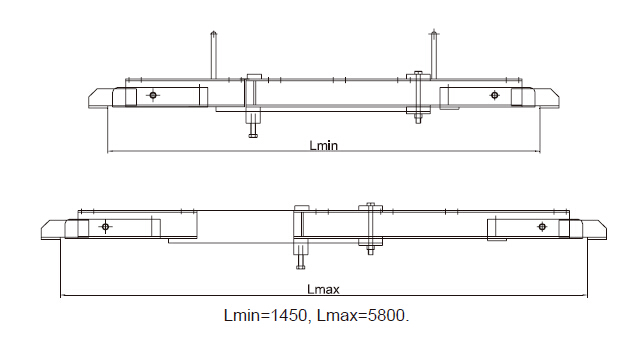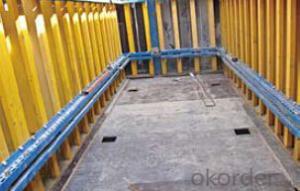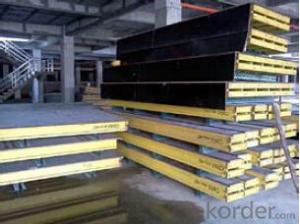Shaft-platform System for Formwork and Scaffolding
- Loading Port:
- Tianjin
- Payment Terms:
- TT OR LC
- Min Order Qty:
- 50 m²
- Supply Capability:
- 1000 m²/month
OKorder Service Pledge
Quality Product, Order Online Tracking, Timely Delivery
OKorder Financial Service
Credit Rating, Credit Services, Credit Purchasing
You Might Also Like
Shaft Platform
As operating platform, the shaft platform is mainly used in the concrete pouring of elevator shaft,
equipment shaft, stair shaft of high-rise building and so on.
Characteristics:
◆ The length of shaft beam is adjustable.
◆ Flexible structure makes lifting easier.


- Q: How is steel formwork supported during concrete pouring?
- Steel formwork is supported during concrete pouring through a system of props, beams, and scaffolding. Props are vertical supports that are strategically placed beneath the steel formwork to provide stability and prevent any sagging or collapsing under the weight of the wet concrete. These props are typically adjustable, allowing for precise positioning and leveling of the formwork. In addition to props, horizontal beams are used to provide further support to the steel formwork. These beams are usually placed at regular intervals and are connected to the props, creating a sturdy framework that can withstand the pressure exerted by the concrete. The beams also help distribute the load evenly across the formwork, ensuring that it remains balanced and secure. Scaffolding is another crucial component in supporting steel formwork during concrete pouring. It is erected around the formwork to provide a safe working platform for workers to access and maneuver the formwork. Scaffolding also assists in the installation and removal of the formwork, enabling efficient construction processes. Overall, the combination of props, beams, and scaffolding plays a vital role in supporting steel formwork during concrete pouring. This support system ensures that the formwork remains stable, allowing the concrete to be poured and cured accurately, resulting in a strong and durable structure.
- Q: What are the different types of formwork release agents used with steel formwork?
- There are several different types of formwork release agents that can be used with steel formwork. These agents are applied to the surface of the formwork before concrete is poured, helping to prevent the concrete from sticking to the steel and making it easier to remove the formwork once the concrete has cured. One common type of formwork release agent used with steel formwork is a petroleum-based release agent. This type of agent is made from a mixture of petroleum oils and other additives, and it provides a thin, lubricating film on the surface of the steel formwork. This film helps to reduce the friction between the formwork and the concrete, making it easier to remove the formwork without damaging the concrete surface. Another type of formwork release agent that can be used with steel formwork is a water-based release agent. This type of agent is typically made from a mixture of water, surfactants, and other additives. It forms a barrier between the steel formwork and the concrete, preventing the concrete from adhering to the surface of the formwork. Water-based release agents are often preferred in situations where environmental concerns or safety considerations make petroleum-based agents less desirable. In addition to petroleum-based and water-based release agents, there are also specialty formwork release agents available for use with steel formwork. These specialty agents may be designed for specific applications or to meet certain performance requirements. For example, there are high-performance release agents that are formulated to provide a superior release of the formwork, even in challenging conditions such as high temperatures or high humidity. There are also release agents that are specifically designed for use with certain types of concrete, such as self-consolidating concrete or high-strength concrete. Overall, the choice of formwork release agent for use with steel formwork will depend on factors such as the specific requirements of the project, environmental considerations, and personal preferences. It is important to carefully select the appropriate release agent and apply it correctly to ensure the successful removal of the formwork and the desired finish of the concrete surface.
- Q: Can steel formwork be used for high-rise buildings?
- Yes, steel formwork can be used for high-rise buildings. Steel formwork offers several advantages such as durability, strength, and flexibility, making it suitable for large and complex structures like high-rise buildings. It can withstand the pressure exerted by concrete, ensuring structural stability during the construction process. Additionally, steel formwork allows for smooth and precise concrete finishing, facilitating the construction of high-quality, aesthetically appealing high-rise buildings.
- Q: Can steel formwork be used for structures with high chemical resistance requirements?
- No, steel formwork is not suitable for structures with high chemical resistance requirements. Steel is prone to corrosion and is not resistant to many harsh chemicals. When exposed to chemicals, steel formwork can deteriorate and lose its structural integrity, compromising the stability and safety of the structure. In such cases, alternative materials like chemically resistant plastics or composites should be considered to ensure the longevity and durability of the structure in environments with high chemical exposure.
- Q: Is steel formwork more environmentally friendly than other types of formwork?
- There is no definitive answer to whether steel formwork is more environmentally friendly than other types of formwork as it depends on various factors. While steel formwork requires a significant amount of energy to produce, it is highly durable and reusable, which reduces waste over time. On the other hand, materials like wood or bamboo formwork are renewable and biodegradable, but may need to be replaced more frequently. Ultimately, the environmental impact of formwork depends on the specific context and considerations of the project.
- Q: Can steel formwork be used for retaining walls?
- Yes, steel formwork can be used for retaining walls. Steel formwork is a popular choice for retaining walls due to its durability and strength. It provides excellent support and stability to the concrete during the construction process. Steel formwork is capable of withstanding the pressure exerted by the concrete and the soil behind the retaining wall, ensuring that the structure remains intact. Additionally, steel formwork offers flexibility in terms of shape and size, allowing for the construction of various retaining wall designs. Overall, steel formwork is a reliable and efficient choice for retaining walls, offering long-lasting performance and ease of construction.
- Q: Can steel formwork be used for school construction projects?
- Yes, steel formwork can be used for school construction projects. Steel formwork is a durable and versatile construction material that can withstand the heavy loads and pressures encountered in school buildings. It provides a strong and stable framework for concrete pouring, ensuring the structural integrity of the construction. Additionally, steel formwork is reusable, which makes it a cost-effective choice for school construction projects. Its adaptability allows for the creation of various shapes and sizes, catering to the unique architectural designs often seen in school buildings. Furthermore, steel formwork offers faster construction times compared to traditional timber formwork, allowing for quicker completion of school projects. Overall, steel formwork is a suitable and reliable choice for school construction projects.
- Q: How does steel formwork handle different concrete surface gloss levels?
- Steel formwork is a versatile and durable option for dealing with different levels of gloss on concrete surfaces. Its ability to create a consistent and even finish is due to its smooth and rigid nature. When it comes to achieving different levels of gloss on concrete surfaces, steel formwork has several advantages. Firstly, it offers a smooth and uniform surface, which is crucial for achieving a high gloss finish. The steel panels are meticulously constructed to create a seamless surface, minimizing any irregularities that could affect the desired gloss level. In addition, steel formwork is highly resistant to warping or bending under the weight of the concrete. This ensures that the surface remains level and consistent, which is particularly important when aiming for a glossy finish. Any inconsistencies in the formwork could lead to uneven concrete placement and variations in gloss. Moreover, steel formwork is reusable, making it cost-effective and environmentally friendly. With proper maintenance and care, it can be used for multiple projects, ensuring consistent results in terms of gloss levels. In conclusion, steel formwork is an excellent choice for handling different levels of gloss on concrete surfaces. Its smooth and rigid construction guarantees a uniform finish, while its durability ensures consistent results. Steel formwork provides an efficient and effective solution for achieving various gloss levels in concrete construction projects.
- Q: How does steel formwork affect the overall durability of the structure?
- Steel formwork can have a significant impact on the overall durability of a structure. Steel is known for its strength and durability, making it an ideal material for formwork. One of the key ways in which steel formwork affects the durability of a structure is through its ability to withstand the forces and pressures exerted during the construction process. Steel formwork provides excellent support and stability to the concrete during pouring and curing, ensuring that it maintains its shape and strength. This helps to prevent any deformation or cracking that could compromise the overall durability of the structure. Additionally, steel formwork is highly resistant to wear and tear, which is crucial for projects that involve multiple concrete pours. Unlike other types of formwork such as timber, steel formwork does not warp, shrink, or expand due to moisture or temperature changes. This allows for multiple uses and reuses, reducing the need for frequent replacements and ultimately increasing the lifespan of the structure. Furthermore, steel formwork offers superior protection against environmental factors such as corrosion and fire. Steel is inherently resistant to rust and decay, which can significantly extend the lifespan of the formwork and consequently the structure itself. Moreover, steel formwork provides higher fire resistance compared to other materials, reducing the risk of structural damage and enhancing the overall durability of the building. In summary, steel formwork positively affects the overall durability of a structure by providing excellent support, stability, and protection against various forces and environmental factors. Its strength, resistance to wear and tear, and superior properties make it a reliable choice for construction projects, ensuring the longevity and durability of the structure.
- Q: How does steel formwork affect the overall durability of a structure?
- Steel formwork can have a significant impact on the overall durability of a structure. Due to its inherent strength and durability, steel formwork provides excellent support and stability during the construction process. This ensures that the structure is built accurately and to the required specifications, which is crucial for long-term durability. One of the main advantages of using steel formwork is its ability to withstand high pressures and loads. This is especially important in large-scale construction projects where heavy concrete pours are involved. The steel formwork can effectively distribute the weight and pressure exerted by the concrete, preventing any deformation or collapse. This ensures that the structure retains its integrity and remains durable over time. Additionally, steel formwork is highly resistant to environmental factors such as moisture, humidity, and temperature variations. This resistance helps protect the structure from potential damage caused by these factors, such as corrosion, rot, or warping. As a result, the overall durability of the structure is enhanced, ensuring its longevity and minimizing the need for costly repairs or maintenance. Furthermore, steel formwork provides a smooth and even surface for the concrete to adhere to during the curing process. This results in a uniform and consistent finish, reducing the risk of cracks or weak points in the structure. The absence of such defects improves the overall durability of the structure, as it is less prone to structural weaknesses that can compromise its integrity over time. Moreover, steel formwork is reusable and can be easily dismantled and reassembled for multiple construction projects. This not only reduces construction costs but also minimizes waste and environmental impact. The ability to reuse steel formwork ensures that the structure is built with high-quality materials consistently, contributing to its long-term durability. In conclusion, steel formwork significantly affects the overall durability of a structure. Its strength, resistance to environmental factors, ability to distribute loads, and provision of a uniform finish all contribute to the long-term durability and structural integrity of the building. By using steel formwork, builders can ensure that the structure is built to last, minimizing the need for repairs or replacements in the future.
Send your message to us
Shaft-platform System for Formwork and Scaffolding
- Loading Port:
- Tianjin
- Payment Terms:
- TT OR LC
- Min Order Qty:
- 50 m²
- Supply Capability:
- 1000 m²/month
OKorder Service Pledge
Quality Product, Order Online Tracking, Timely Delivery
OKorder Financial Service
Credit Rating, Credit Services, Credit Purchasing
Similar products
Hot products
Hot Searches
Related keywords



















